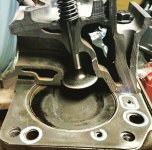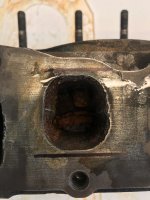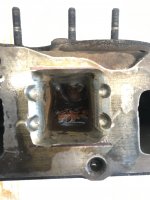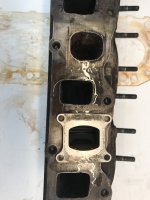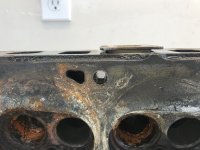How would you get the reeds close to the valves would you machine like a slot in the valve cover area or bottom of the head to slide it in?
You are using an out of date browser. It may not display this or other websites correctly.
You should upgrade or use an alternative browser.
You should upgrade or use an alternative browser.
Reed valve
- Thread starter Wesman07
- Start date
One way is to find a reed valve assembly to fit inside the intake port but the small reed assembly might obstruct high rpm flow.How would you get the reeds close to the valves would you machine like a slot in the valve cover area or bottom of the head to slide it in?
A second way might be to use a larger reed assembly that sits between the intake manifold and the head.
Interesting! Thank you pmuller!
So I was doing some work in my buddy’s air plane hanger today and I see a ktm 65 stuffed in the corner. I said “Jay, do you have a reed valve laying around for that thing?”. Sure enough, he did.
The sizing is very close. My only concern is the inlet on the reed valve is too small. I don’t know if it can be modified or if that’s all the air it will flow.
My next step is to take a junk head and run it through his band saw. I really need to see how much I can open the entrance of the intake port. Also, I’d like to see if I can recess the reed flush with the head surface.
The sizing is very close. My only concern is the inlet on the reed valve is too small. I don’t know if it can be modified or if that’s all the air it will flow.
My next step is to take a junk head and run it through his band saw. I really need to see how much I can open the entrance of the intake port. Also, I’d like to see if I can recess the reed flush with the head surface.
Attachments
-
 EE6CF9C8-D234-408C-89A1-8BB0722C9F61.jpeg1.3 MB · Views: 6
EE6CF9C8-D234-408C-89A1-8BB0722C9F61.jpeg1.3 MB · Views: 6 -
 36F2448E-7674-4F02-BAE7-F0674B129CA7.jpeg1.4 MB · Views: 5
36F2448E-7674-4F02-BAE7-F0674B129CA7.jpeg1.4 MB · Views: 5 -
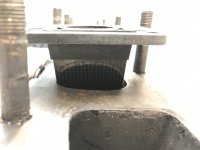 0F2243F2-4C9A-4D41-9003-B0AC2CF4CBD5.jpeg808.3 KB · Views: 5
0F2243F2-4C9A-4D41-9003-B0AC2CF4CBD5.jpeg808.3 KB · Views: 5 -
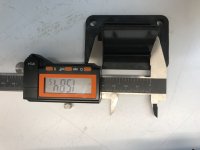 C8B453FA-5C60-4931-A022-77FFBE751444.jpeg1 MB · Views: 5
C8B453FA-5C60-4931-A022-77FFBE751444.jpeg1 MB · Views: 5 -
 5018B145-5600-4223-BDD9-FBA43D0062DB.jpeg1.2 MB · Views: 5
5018B145-5600-4223-BDD9-FBA43D0062DB.jpeg1.2 MB · Views: 5 -
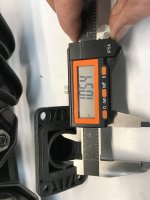 C991A342-B2BF-4A31-A66D-C1ECDEEC3ED4.jpeg1.2 MB · Views: 5
C991A342-B2BF-4A31-A66D-C1ECDEEC3ED4.jpeg1.2 MB · Views: 5 -
 669E8C0D-F2EE-4449-A12D-E0DD2DDC1C4D.jpeg1.1 MB · Views: 6
669E8C0D-F2EE-4449-A12D-E0DD2DDC1C4D.jpeg1.1 MB · Views: 6
Last edited:
After thinking about it a little more. I wouldn’t modify these V force reeds. They use a click together design that eliminates screws through the peddles. They have a tendency to warp if over heated as is. Removing material might make that worse.
The aluminum boyesen or factory ktm reeds should be more forgiving.
ps. Thanks pmuller9 for running the math for pressure against the reeds.
The aluminum boyesen or factory ktm reeds should be more forgiving.
ps. Thanks pmuller9 for running the math for pressure against the reeds.
Last edited:
Interesting was your idea to then machine like a little stepped ledge at the port opening for a reed to set into where its flush with the gasket surface, either in the intake manifold or into the head?
Yes, that was one of the options I’m exploring. It would be nice to set the reeds as far as possible to minimize the volume behind the intake valve. The other nice thing about that is any exhaust/ intake combo would bolt right up.
The other option would be to modify the intake or exhaust flange to adapt.
Looking at FTF’s cut away photo, it will be close. The water jacket above the intake port does look like a spot that could be filled with epoxy.
The other option would be to modify the intake or exhaust flange to adapt.
Looking at FTF’s cut away photo, it will be close. The water jacket above the intake port does look like a spot that could be filled with epoxy.
Attachments
Last edited:
So I found a reed valve that is more promising from a flow standpoint. This one is about the maximum size I am hopeful will fit into the intake port. I think I can do some porting to the cage and modify the reed peddle stops to squeeze a little more flow out of it at the cost of longevity.
The next step is taking a cylinder head to a band saw. Once I see a cross section of the intake port entrance, I will know what I really have to work with.
The next step is taking a cylinder head to a band saw. Once I see a cross section of the intake port entrance, I will know what I really have to work with.
Attachments
-
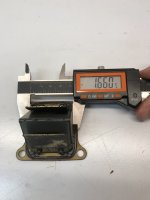 744C6E34-67CE-49B3-92E5-947740F44431.jpeg1.1 MB · Views: 7
744C6E34-67CE-49B3-92E5-947740F44431.jpeg1.1 MB · Views: 7 -
 C4BB0477-0FF0-4AD5-A24A-086CD3DFC947.jpeg1.2 MB · Views: 4
C4BB0477-0FF0-4AD5-A24A-086CD3DFC947.jpeg1.2 MB · Views: 4 -
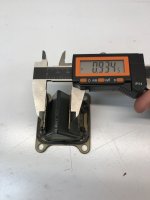 3CFFCD50-1B92-4A37-8834-3C624E7826D9.jpeg1.1 MB · Views: 4
3CFFCD50-1B92-4A37-8834-3C624E7826D9.jpeg1.1 MB · Views: 4 -
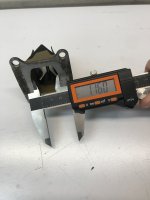 0DC728EF-BE3B-466D-B9C2-197C4B8D91EF.jpeg1.3 MB · Views: 6
0DC728EF-BE3B-466D-B9C2-197C4B8D91EF.jpeg1.3 MB · Views: 6 -
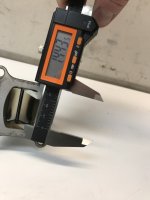 A025A39C-F622-4316-95FD-E561AA03913E.jpeg718.9 KB · Views: 5
A025A39C-F622-4316-95FD-E561AA03913E.jpeg718.9 KB · Views: 5 -
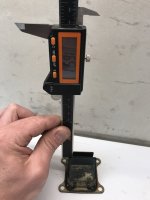 782FA1A1-F5F8-498F-A525-1AB91544B03A.jpeg909.8 KB · Views: 6
782FA1A1-F5F8-498F-A525-1AB91544B03A.jpeg909.8 KB · Views: 6 -
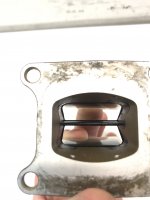 A757EB68-295D-4EB7-A555-B6D18D52E873.jpeg613.3 KB · Views: 6
A757EB68-295D-4EB7-A555-B6D18D52E873.jpeg613.3 KB · Views: 6
Quick update. I picked up a third reed valve to try and I also made some decent sections of a junk head.
With one of the reeds I have now, I should be able to maintain port size if the reed hangs out 5/8”.
My next move is going to be making one fit. One of the challenges I’m running into is all of reeds I’m finding are all wider than they are tall, forcing me to clock it 90 degrees.
With one of the reeds I have now, I should be able to maintain port size if the reed hangs out 5/8”.
My next move is going to be making one fit. One of the challenges I’m running into is all of reeds I’m finding are all wider than they are tall, forcing me to clock it 90 degrees.
Attachments
-
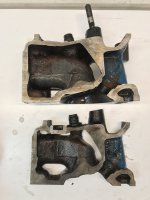 0CCEAF74-22E5-40DD-9EA8-F2851CA7E5EB.jpeg1.6 MB · Views: 6
0CCEAF74-22E5-40DD-9EA8-F2851CA7E5EB.jpeg1.6 MB · Views: 6 -
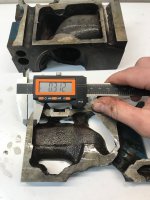 A504DE9C-16F7-4837-BECA-985048F43324.jpeg1.6 MB · Views: 3
A504DE9C-16F7-4837-BECA-985048F43324.jpeg1.6 MB · Views: 3 -
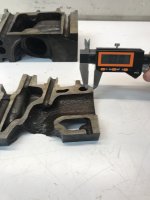 91CDD83F-41AD-4BE4-8CF0-183DBADFA065.jpeg922.1 KB · Views: 3
91CDD83F-41AD-4BE4-8CF0-183DBADFA065.jpeg922.1 KB · Views: 3 -
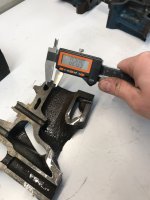 99D0D4B5-91C2-4DAC-91A4-8EE13B412B33.jpeg979.1 KB · Views: 4
99D0D4B5-91C2-4DAC-91A4-8EE13B412B33.jpeg979.1 KB · Views: 4 -
 6EAFC469-A521-4007-9637-54D3873705D2.jpeg1 MB · Views: 5
6EAFC469-A521-4007-9637-54D3873705D2.jpeg1 MB · Views: 5 -
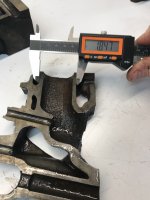 6BD89E90-5EAE-42F4-A806-28A4FE8D3318.jpeg1 MB · Views: 5
6BD89E90-5EAE-42F4-A806-28A4FE8D3318.jpeg1 MB · Views: 5 -
 3478CCDC-84A1-49C3-A1BE-A408141873CB.jpeg1.8 MB · Views: 7
3478CCDC-84A1-49C3-A1BE-A408141873CB.jpeg1.8 MB · Views: 7 -
 ECA1E676-C869-4D97-BD85-C1338EC1DE14.jpeg1.4 MB · Views: 7
ECA1E676-C869-4D97-BD85-C1338EC1DE14.jpeg1.4 MB · Views: 7 -
 66241AE0-7C00-4F68-9664-BDB2CEC4A80B.jpeg1.3 MB · Views: 7
66241AE0-7C00-4F68-9664-BDB2CEC4A80B.jpeg1.3 MB · Views: 7
Probably these?
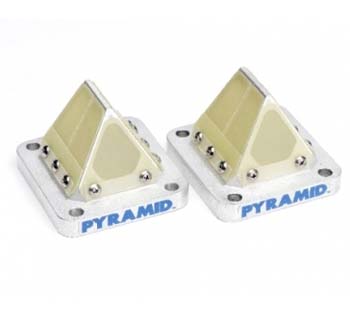
 www.duncanracing.com
www.duncanracing.com
I am actively “cost engineering” (as we say in construction) the project. One day I’d like this to be considered a “red neck supercharger”. If I can make an oem production reed work, it will from $150-200 per reed to $50. It’s an avenue worth traveling.

Pyramid Reed Valve Yamaha Banshee — Duncan Racing
NOTE: IN STOCK Purchase Options Part # PRV-350 Pyramid Reed Valve $399.00 Yamaha Banshee Part # PRV-935 Replacement Reeds $79.95 for: PRV-350 Part # PRV-SCREW Replacement Screws (each) .20 (To order screws see related item bottom of page) Unique 4-Sided design offers a power gain at all R
I am actively “cost engineering” (as we say in construction) the project. One day I’d like this to be considered a “red neck supercharger”. If I can make an oem production reed work, it will from $150-200 per reed to $50. It’s an avenue worth traveling.
How about a pyramid configuration but with the reeds on the inside of the cage, that way instead of it needing to fit into the head port, it could fit and face inside the intake; where there is more room for modification. I know you trying to fit it as close to the valve as possible, but for design modifications it would be more forgiving.
I’d had thought about doing something similar but it gets complicated with the injector. The reeds would need to move about four to five inches back, more than doubling the volume between the valve and reed. It would be nice to have the injector down stream of the reed though.
The reed hanging out of the port will create another hurdle but I think it’s easy to get over. I’m thinking the reed will need a spacer between it and the head. Then, I would need a stepped flange washer made and use longer bolts to hold both manifolds on. Hopefully I can find a way to simplify that design.
My calculators shows the 1.5x1.3” port size flowing 205cfm, which passes the “smell test”. In order to keep the upper end of the power band, I’ll need to take the creative path rather than the easy one.
One thing I do have going for me is that I should be able to make up for a loss in flow by holding the intake valve open longer than usual. This would allow more time for cylinder fill without worrying about the losing bottom end power. The ideal cam profile would look like a large turbo cam with some overlap.
The reed hanging out of the port will create another hurdle but I think it’s easy to get over. I’m thinking the reed will need a spacer between it and the head. Then, I would need a stepped flange washer made and use longer bolts to hold both manifolds on. Hopefully I can find a way to simplify that design.
My calculators shows the 1.5x1.3” port size flowing 205cfm, which passes the “smell test”. In order to keep the upper end of the power band, I’ll need to take the creative path rather than the easy one.
One thing I do have going for me is that I should be able to make up for a loss in flow by holding the intake valve open longer than usual. This would allow more time for cylinder fill without worrying about the losing bottom end power. The ideal cam profile would look like a large turbo cam with some overlap.
Last edited:
Here this the shape I was talking about, wrong country, wrong size, but right shape... https//aerobertics.be/en_be/da025
I might have a little bit of wild idea here…
How possible is it to make a new intake port entrance? If the port entrance could be increased, a larger reed could fit and there would be little to no hindrance in flow. Reed life would also be increased. Another benefit would be the manifolds and mounting could probably be left alone.
If the reeds are only 2” in depth, it seems possible to me that I could make a new port entrance and weld or braze the new one in. After some hand work the head would need to get resurfaced.
Maybe my stomach is bigger than my mouth?
How possible is it to make a new intake port entrance? If the port entrance could be increased, a larger reed could fit and there would be little to no hindrance in flow. Reed life would also be increased. Another benefit would be the manifolds and mounting could probably be left alone.
If the reeds are only 2” in depth, it seems possible to me that I could make a new port entrance and weld or braze the new one in. After some hand work the head would need to get resurfaced.
Maybe my stomach is bigger than my mouth?
To me this sounds like the way to go its easy to add some weld buildup at the intake port entrance's and then machine it especially if it's an Aluminum one. You could also make a solid plate fixture to bolt the intake to and help keep everything in alignment during the welding. Best of luck
I was able to get the larger reed valve in a little farther than I thought. I broke through to water in the upper right corner which I expected and admittedly got a little sloppy.
Attachments
Last edited:
OK so, I'm coming to the conclusion that the best reed valve option would be off a KX 85 -100cc which is the last and largest reed I tried to fit. After taking closer measurements of the intake port, I feel confident that the reed cage itself will be able to flow about as much as the intake port after some minor adjustments. My estimation is 200CFM @ 28".
The next step I plan to take is perform a simple floating pressure drop test to verify my estimations. The vacuum will need to be strong enough to fully open the reeds. Using an unmodified head and a large valve ported head I can establish benchmarks indicating flow results that can be compared to flow tests others have performed and published. The largest flow impediment I predict will be the reed pedals themselves because of the constant spring pressure produced. This has me searching for the lowest tension pedal. Low tension pedals will not only be easier to open but will flutter at a lower frequency, possibly allowing the reed to hang open at higher RPMS.
Another modification I will be testing is the adjustment of the reed stops. By opening them up, maximum flow should be improved as well as creating a less progressive spring rate. As the pedals lay against the stops, the free length of the pedal decreases, creating a stiffer spring rate.
Service life of the reed will be the biggest question. KX 85 reeds should last about 100hrs. By installing these into a 4 cycle ford 6, I'm estimating that the service life could increase 4x. The reeds will be exposed to half the rpm and half of the intake strokes at a given rpm. The only thing would decrease service life would be the increased length at which the reed will bend. 400hrs @ at say an average of 45mph is 18,000 miles.... not terrible. OEM KX 85 reeds can be purchased off or E bay for about $20 and reed pedals for about $40, putting this project at under $400.
The next step I plan to take is perform a simple floating pressure drop test to verify my estimations. The vacuum will need to be strong enough to fully open the reeds. Using an unmodified head and a large valve ported head I can establish benchmarks indicating flow results that can be compared to flow tests others have performed and published. The largest flow impediment I predict will be the reed pedals themselves because of the constant spring pressure produced. This has me searching for the lowest tension pedal. Low tension pedals will not only be easier to open but will flutter at a lower frequency, possibly allowing the reed to hang open at higher RPMS.
Another modification I will be testing is the adjustment of the reed stops. By opening them up, maximum flow should be improved as well as creating a less progressive spring rate. As the pedals lay against the stops, the free length of the pedal decreases, creating a stiffer spring rate.
Service life of the reed will be the biggest question. KX 85 reeds should last about 100hrs. By installing these into a 4 cycle ford 6, I'm estimating that the service life could increase 4x. The reeds will be exposed to half the rpm and half of the intake strokes at a given rpm. The only thing would decrease service life would be the increased length at which the reed will bend. 400hrs @ at say an average of 45mph is 18,000 miles.... not terrible. OEM KX 85 reeds can be purchased off or E bay for about $20 and reed pedals for about $40, putting this project at under $400.
Last edited:
Firepower354
Famous Member
I don't see going back to the beginning, Intake over Exhaust, atmospheric, as a fix.
I have a basket of reed blocks/cages, and some lopped off intake ports to fit. Retrofitted plenty on 2 strokes.
GEM reed kits for early PP bikes were popular, and period testing backed up the restriction on top, without added porting. Boost ports, Boyesen ports, holed/arched piston skirts, etc
Modern mega-cages suffer very little. CF reeds are available in many thicknesses to tailor stiffness.
PP engines can be ported for very low speeds, several industrial applications, Briggs R-Tec, Robin/Wisconsin 125, etc. But, to do low and high, reeds are needed. One can have essentially 360 degree port timing, and let the reeds meter the one way flow.
In a 4t, meh. Honda used a tiny 4 petal unit from the CR80, and WB promptly created a replacement stuffer. Same with the more recent KTM, added farther back, for Euro standards. Just yanking the reeds and leaving the big rectangular duct kills low end, but replacing it with a round tube is a gain everywhere.
Aylor reeds for a Kaw triple are much smaller than previously accepted as needed, and still make big power.
But, apples & Aardvarks, in that the intake resonances are far different.
VVT via Rhodes lifters, seems underutilized.
Evolution of my case reed golf cart from 3 thin slots, to one Boyesen dual-stage, to an 8-petal sled cage.
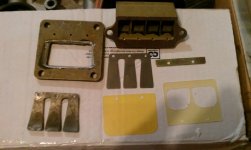
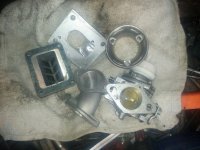

I have a basket of reed blocks/cages, and some lopped off intake ports to fit. Retrofitted plenty on 2 strokes.
GEM reed kits for early PP bikes were popular, and period testing backed up the restriction on top, without added porting. Boost ports, Boyesen ports, holed/arched piston skirts, etc
Modern mega-cages suffer very little. CF reeds are available in many thicknesses to tailor stiffness.
PP engines can be ported for very low speeds, several industrial applications, Briggs R-Tec, Robin/Wisconsin 125, etc. But, to do low and high, reeds are needed. One can have essentially 360 degree port timing, and let the reeds meter the one way flow.
In a 4t, meh. Honda used a tiny 4 petal unit from the CR80, and WB promptly created a replacement stuffer. Same with the more recent KTM, added farther back, for Euro standards. Just yanking the reeds and leaving the big rectangular duct kills low end, but replacing it with a round tube is a gain everywhere.
Aylor reeds for a Kaw triple are much smaller than previously accepted as needed, and still make big power.
But, apples & Aardvarks, in that the intake resonances are far different.
VVT via Rhodes lifters, seems underutilized.
Evolution of my case reed golf cart from 3 thin slots, to one Boyesen dual-stage, to an 8-petal sled cage.



Last edited:


